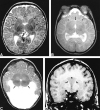Assessment of the deep gray nuclei in holoprosencephaly
- PMID: 11110554
- PMCID: PMC7974288
Assessment of the deep gray nuclei in holoprosencephaly
Abstract
Background and purpose: Although holoprosencephaly has been known for many years, few detailed analyses have been performed in a large series of patients to outline the range of morphology in this disorder, particularly regarding the deep gray nuclear structures. We reviewed a large patient cohort to elucidate the combinations of morphologic aberrations of the deep gray nuclei and to correlate those findings with recent discoveries in embryology and developmental neurogenetics.
Methods: A retrospective review of the imaging records of 57 patients (43 MR studies and 14 high-quality CT studies) to categorize the spectrum of deep gray nuclear malformations. The hypothalami, caudate nuclei, lentiform nuclei, thalami, and mesencephalon were graded as to their degree of noncleavage. Spatial orientation was also evaluated, as was the relationship of the basal ganglia to the diencephalic structures and mesencephalon. The extent of noncleavage of the various nuclei was then assessed for statistical association.
Results: In every study on which it could be accurately assessed, we found some degree of hypothalamic noncleavage. Noncleavage was also common in the caudate nuclei (96%), lentiform nuclei (85%), and thalami (67%). Complete and partial noncleavage were more common in the caudate nuclei than in the lentiform nuclei. The degree of thalamic noncleavage was uniformly less than that in the caudate and lentiform nuclei. Abnormalities in alignment of the long axis of the thalamus were seen in 71% of cases, and were associated with degree of thalamic noncleavage; 27% of patients had some degree of mesencephalic noncleavage.
Conclusion: The hypothalamus and caudate nuclei are the most severely affected structures in holoprosencephaly, and the mesencephalic structures are more commonly involved than previously thought in this "prosencephalic disorder." These findings suggest the lack of induction of the most rostral aspects of the embryonic floor plate as the cause of this disorder.
Figures




References
-
- DeMyer W, Zeman W. Alobar holoprosencephaly (arhinencephaly) with median cleft lip and palate: clinical, nosologic, and electroencephalographic considerations. Confin Neurol 1963;23:1-36 - PubMed
-
- DeMyer W, Zeman W, Palmer CG. The face predicts the brain: diagnostic significance of median facial anomalies for holoprosencephaly (arhinencephaly). Pediatrics 1964;34:256-263 - PubMed
-
- Probst FP. The Prosencephalies: Morphology, Neuroradiological Appearances and Differential Diagnosis.. New York: Springer; 1979
-
- Kobori JA, Herrick MK, Urich H. Arhinencephaly: the spectrum of associated malformations. Brain 1987;110:237-260 - PubMed
-
- Sulik KK, Johnston MC. Embryonic origin of holoprosencephaly: interrelationship of the developing brain and face. Scan Elec Microsc 1982;260:309-322 - PubMed
Publication types
MeSH terms
Grants and funding
LinkOut - more resources
Full Text Sources
